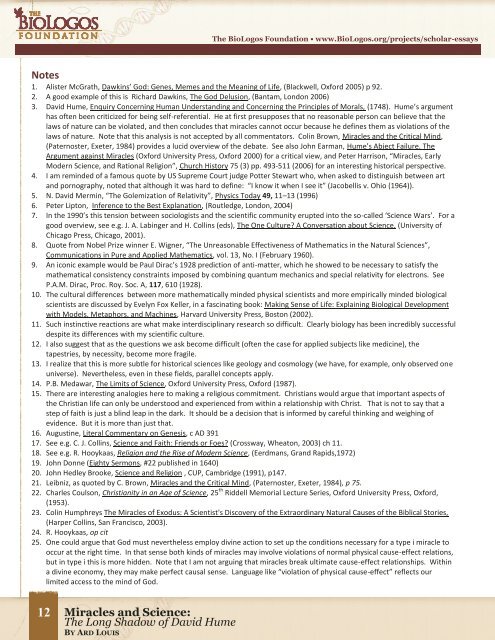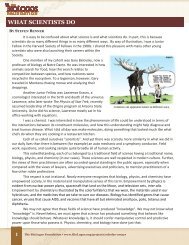Miracles and Science: The Long Shadow of David Hume - BioLogos
Miracles and Science: The Long Shadow of David Hume - BioLogos
Miracles and Science: The Long Shadow of David Hume - BioLogos
Create successful ePaper yourself
Turn your PDF publications into a flip-book with our unique Google optimized e-Paper software.
<strong>The</strong> <strong>BioLogos</strong> Foundation • www.<strong>BioLogos</strong>.org/projects/scholar-essays<br />
Notes<br />
1. Alister McGrath, Dawkins’ God: Genes, Memes <strong>and</strong> the Meaning <strong>of</strong> Life, (Blackwell, Oxford 2005) p 92.<br />
2. A good example <strong>of</strong> this is Richard Dawkins, <strong>The</strong> God Delusion, (Bantam, London 2006)<br />
3. <strong>David</strong> <strong>Hume</strong>, Enquiry Concerning Human Underst<strong>and</strong>ing <strong>and</strong> Concerning the Principles <strong>of</strong> Morals, (1748). <strong>Hume</strong>’s argument<br />
has <strong>of</strong>ten been criticized for being self-referential. He at first presupposes that no reasonable person can believe that the<br />
laws <strong>of</strong> nature can be violated, <strong>and</strong> then concludes that miracles cannot occur because he defines them as violations <strong>of</strong> the<br />
laws <strong>of</strong> nature. Note that this analysis is not accepted by all commentators. Colin Brown, <strong>Miracles</strong> <strong>and</strong> the Critical Mind,<br />
(Paternoster, Exeter, 1984) provides a lucid overview <strong>of</strong> the debate. See also John Earman, <strong>Hume</strong>’s Abject Failure. <strong>The</strong><br />
Argument against <strong>Miracles</strong> (Oxford University Press, Oxford 2000) for a critical view, <strong>and</strong> Peter Harrison, “<strong>Miracles</strong>, Early<br />
Modern <strong>Science</strong>, <strong>and</strong> Rational Religion”, Church History 75 (3) pp. 493-511 (2006) for an interesting historical perspective.<br />
4. I am reminded <strong>of</strong> a famous quote by US Supreme Court judge Potter Stewart who, when asked to distinguish between art<br />
<strong>and</strong> pornography, noted that although it was hard to define: “I know it when I see it” (Jacobellis v. Ohio (1964)).<br />
5. N. <strong>David</strong> Mermin, “<strong>The</strong> Golemization <strong>of</strong> Relativity”, Physics Today 49, 11–13 (1996)<br />
6. Peter Lipton, Inference to the Best Explanation, (Routledge, London, 2004)<br />
7. In the 1990’s this tension between sociologists <strong>and</strong> the scientific community erupted into the so-called ‘<strong>Science</strong> Wars’. For a<br />
good overview, see e.g. J. A. Labinger <strong>and</strong> H. Collins (eds), <strong>The</strong> One Culture A Conversation about <strong>Science</strong>, (University <strong>of</strong><br />
Chicago Press, Chicago, 2001).<br />
8. Quote from Nobel Prize winner E. Wigner, “<strong>The</strong> Unreasonable Effectiveness <strong>of</strong> Mathematics in the Natural <strong>Science</strong>s”,<br />
Communications in Pure <strong>and</strong> Applied Mathematics, vol. 13, No. I (February 1960).<br />
9. An iconic example would be Paul Dirac’s 1928 prediction <strong>of</strong> anti-matter, which he showed to be necessary to satisfy the<br />
mathematical consistency constraints imposed by combining quantum mechanics <strong>and</strong> special relativity for electrons. See<br />
P.A.M. Dirac, Proc. Roy. Soc. A, 117, 610 (1928).<br />
10. <strong>The</strong> cultural differences between more mathematically minded physical scientists <strong>and</strong> more empirically minded biological<br />
scientists are discussed by Evelyn Fox Keller, in a fascinating book: Making Sense <strong>of</strong> Life: Explaining Biological Development<br />
with Models, Metaphors, <strong>and</strong> Machines, Harvard University Press, Boston (2002).<br />
11. Such instinctive reactions are what make interdisciplinary research so difficult. Clearly biology has been incredibly successful<br />
despite its differences with my scientific culture.<br />
12. I also suggest that as the questions we ask become difficult (<strong>of</strong>ten the case for applied subjects like medicine), the<br />
tapestries, by necessity, become more fragile.<br />
13. I realize that this is more subtle for historical sciences like geology <strong>and</strong> cosmology (we have, for example, only observed one<br />
universe). Nevertheless, even in these fields, parallel concepts apply.<br />
14. P.B. Medawar, <strong>The</strong> Limits <strong>of</strong> <strong>Science</strong>, Oxford University Press, Oxford (1987).<br />
15. <strong>The</strong>re are interesting analogies here to making a religious commitment. Christians would argue that important aspects <strong>of</strong><br />
the Christian life can only be understood <strong>and</strong> experienced from within a relationship with Christ. That is not to say that a<br />
step <strong>of</strong> faith is just a blind leap in the dark. It should be a decision that is informed by careful thinking <strong>and</strong> weighing <strong>of</strong><br />
evidence. But it is more than just that.<br />
16. Augustine, Literal Commentary on Genesis, c AD 391<br />
17. See e.g. C. J. Collins, <strong>Science</strong> <strong>and</strong> Faith: Friends or Foes (Crossway, Wheaton, 2003) ch 11.<br />
18. See e.g. R. Hooykaas, Religion <strong>and</strong> the Rise <strong>of</strong> Modern <strong>Science</strong>, (Eerdmans, Gr<strong>and</strong> Rapids,1972)<br />
19. John Donne (Eighty Sermons, #22 published in 1640)<br />
20. John Hedley Brooke, <strong>Science</strong> <strong>and</strong> Religion , CUP, Cambridge (1991), p147.<br />
21. Leibniz, as quoted by C. Brown, <strong>Miracles</strong> <strong>and</strong> the Critical Mind, (Paternoster, Exeter, 1984), p 75.<br />
22. Charles Coulson, Christianity in an Age <strong>of</strong> <strong>Science</strong>, 25 th Riddell Memorial Lecture Series, Oxford University Press, Oxford,<br />
(1953).<br />
23. Colin Humphreys <strong>The</strong> <strong>Miracles</strong> <strong>of</strong> Exodus: A Scientist's Discovery <strong>of</strong> the Extraordinary Natural Causes <strong>of</strong> the Biblical Stories,<br />
(Harper Collins, San Francisco, 2003).<br />
24. R. Hooykaas, op cit<br />
25. One could argue that God must nevertheless employ divine action to set up the conditions necessary for a type i miracle to<br />
occur at the right time. In that sense both kinds <strong>of</strong> miracles may involve violations <strong>of</strong> normal physical cause-effect relations,<br />
but in type i this is more hidden. Note that I am not arguing that miracles break ultimate cause-effect relationships. Within<br />
a divine economy, they may make perfect causal sense. Language like “violation <strong>of</strong> physical cause-effect” reflects our<br />
limited access to the mind <strong>of</strong> God.<br />
12<br />
<strong>Miracles</strong> <strong>and</strong> <strong>Science</strong>:<br />
<strong>The</strong> <strong>Long</strong> <strong>Shadow</strong> <strong>of</strong> <strong>David</strong> <strong>Hume</strong><br />
BY ARD LOUIS




